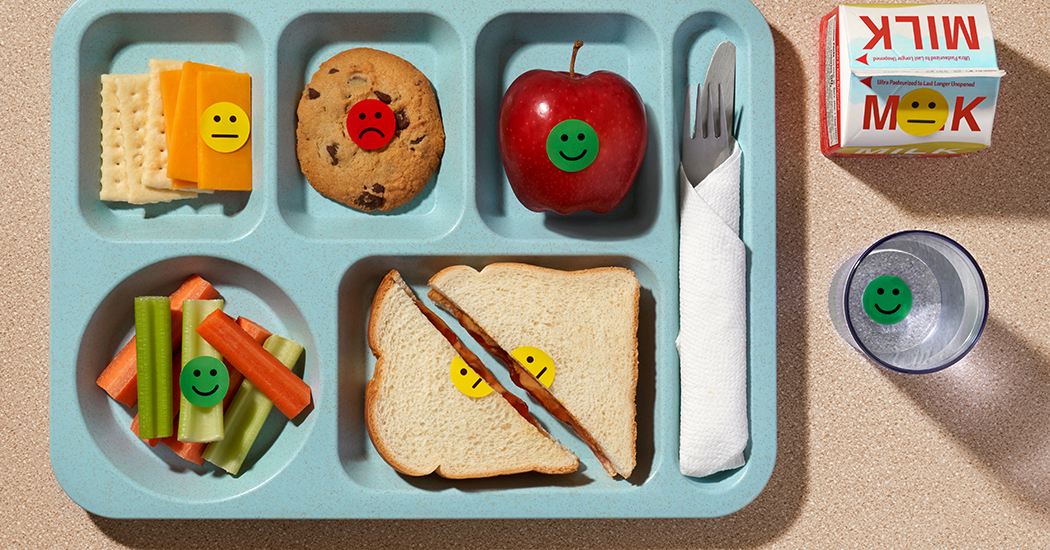Caitlin Kiarie’s 6-year-old son, Emerson, begins every day of remote learning with a class meeting over Zoom. Kiarie, a mom of three in Montclair, N.J., enjoys listening in as she nurses her newborn and helps her third-grader manage his own remote learning. But on one recent morning, the Zoom conversation took an unexpected turn: Emerson’s teacher asked the class to share what they ate for dinner the night before. After every child took a turn, Kiarie heard the teacher say, “I had turkey and vegetables for dinner last night. My husband and I are trying to eat less carbs, so we didn’t eat any bread.”
Kiarie, who is also a registered dietitian specializing in family feeding, was alarmed. “I know it’s a seemingly harmless conversation, but these teachers are role models,” she said. “Some kids are going to hear that and think ‘bread is bad.’” For another recent class assignment, Emerson was asked to group foods like watermelon and doughnuts into “healthy” and “unhealthy” categories.
In Denver, Julie Ralston’s 15-year-old daughter, Katie, received an assignment for a remote weight training class asking her to keep a food log for two weeks where she would count calories and track her intake of proteins, carbohydrates and fat grams, then use that information to develop her own nutrition plan.
Ralston, a former health coach who considers herself in recovery from a disordered relationship with food, was horrified. “Katie was in tears. She said, ‘Every time I go to eat something now, it makes me not want to eat it because I’ll have to write it down,’” she said.
Schools have long incorporated nutrition lessons developed by the United States Department of Agriculture into their curriculums: In the 1980s, children studied a “food wheel,” which became the Food Pyramid in 1992, and was replaced with MyPlate in 2011. And dietitians have been concerned about the impact of these lessons for just about as long. “This issue has always been on my radar,” said Sarah Ganginis, a dietitian who specializes in eating disorder treatment in Ellicott City, Md. “Many of my clients can trace their food anxieties and body dissatisfaction back to something that happened or a comment someone made when they were in gym class or health class or somewhere else at school,” she said.
But the rise of remote schooling has brought a renewed scrutiny to the way educators talk and teach about food and body weight, as parents overhear stray comments on Zoom meetings and print worksheets for aspects of their children’s curriculum they may not have encountered before. “Folks are sending me math problems all about someone counting calories on a diet,” said Anna Lutz, a dietitian in private practice in Raleigh, N.C. She has also heard from parents upset that their children are using a curriculum developed by Nemours, a nonprofit children’s health system, which coaches teenagers through designing their own “healthy weight loss plan.”
Such assignments are common for younger children too: My own first-grader was instructed to keep a fitness log for remote physical education last spring, and track how many minutes a day she moved and whether she did exercises like planks and situps. I didn’t blame the gym teacher, who was clearly struggling to figure out how to teach P.E. over Zoom. But it did get me wondering: Why do dieting and weight loss take center stage in so many school assignments? And what can parents do about it?
The Trouble With Food Labels
School nutrition curriculums are usually written at the county or state level, and must be in accordance with the National Health Education Standards set out by the Centers for Disease Control and Prevention. While the standards themselves are fairly open-ended, the C.D.C. also created the Health Education Curriculum Analysis Tool (known as HECAT) to help school districts make sure their curriculums meet the national standards. For nutrition, HECAT details specific curriculum objectives by age: By grade 2, for example, students should be able to “demonstrate effective refusal skills to avoid unhealthy food choices.” By grade 5, they should be able to “state personal beliefs to improve the food and beverage selections of others.” By grade 8, they should be able to “explain various methods available to evaluate body weight.”
“HECAT is a disaster. We should not be teaching children to weigh themselves or eat to maintain or lose weight,” said Ganginis, who began advocating to change Maryland’s health curriculum after her then-kindergartner came home saying, “My teacher says I’m not allowed to bring potato chips anymore because we have to have a healthy snack.” Many adults would agree that potato chips are not as healthy as, say, apple slices, but what worried Ganginis was her daughter’s sadness and shame around liking a food that her teacher had deemed unhealthy.
“Of course we want kids to learn to enjoy fruits, vegetables and whole grains. But first we have to help them understand that foods can have different nutritional values, but still be emotionally equivalent,” she said.
This distinction is difficult for many adults to grasp when we’ve long internalized messages from diet marketing and other sources about the evils of sugar and other foods. But it’s developmentally even further out of the reach of children, who tend to be quite concrete thinkers. “Nutrition is such a nuanced, complicated and context-based concept, it’s very difficult to drill down into a message for concrete thinkers,” said Katherine Zavodni, a dietitian who works with families in Salt Lake City.
“If we say to kids, ‘Birthday cake is bad for you!’ some children will take that as ‘I can never eat birthday cake,’” Lutz added. But it won’t diminish their desire for birthday cake because forbidding foods only increases a child’s interest in them, as one iconic study showed in 2007. Researchers told some children they could not eat red M&Ms but could eat as many yellow M&Ms as they wanted, while offering M&Ms to other children with no restrictions: The children who were told not to eat red M&Ms became more fixated on them and subsequently ate proportionately more of them when they did gain access, compared to their nonrestricted peers.
“Educators are trained to tailor their educational messages to a student’s cognitive readiness in every subject except nutrition,” Lutz said. She and Zavodni have begun working on their own model curriculum, which they say is more developmentally appropriate and free of the kind of categorization that promotes bias. “We can teach kids facts about food — like how apples grow — without teaching moralistic value statements, just like we can teach kids the names of different religions without teaching them to believe in one religion,” Zavodni said.
When Curriculum Meets Culture
Critics of school nutrition curriculums take particular issue with the goal of teaching children to persuade others to make healthier eating choices. “Kids don’t do the grocery shopping and they don’t control family finances,” Zavodni said. “It’s very fraught to have a public health strategy rely on sending children home to educate the parents.”
Such objectives also fail to acknowledge the cultural and socioeconomic diversity of students. “You can show a kid your idea of a ‘healthy’ plate, but it often doesn’t really relate to them,” said Megan Reikowski, a federal title program coordinator for a large school district in Minnesota’s Twin Cities. She described her district as “primarily white and upper middle class,” but with a growing population of English language learners, migrant children, and homeless or otherwise academically at-risk students, many of whom rely on the school’s free and reduced-cost meal programs and other community resources for most of their nutrition. She worries about how a child in a food-insecure home might feel if he hears that processed foods like ramen noodles are bad, but has to eat them because that’s what his family can afford.
“The vast majority of our multilingual students are the first in their family born in America, so their parents have very different ideas about nutrition and cooking. I think they often see the nutrition information coming home and don’t know how to even begin to cook that way,” Reikowski said. They may also have different ideas about “what a healthy kid looks like,” which can make lessons around body weight troublesome.
On the flip side, Reikowski discourages the teachers she works with from holding up students of color as food role models. “You can’t read ‘Too Many Tamales’ and call on the one Latinx kid in class and ask him to tell everyone about tamales,” she said. “If kids always feel like what they’re eating at home is either being judged as unhealthy or held up like it’s in a museum, it’s really hard for them to talk about what’s actually important to them about food.”
Giving Kids the Wrong Tools
In a perfect world, these advocates say, school nutrition classes could help foster an appreciation for and curiosity about all sorts of foods, while also educating children about issues like food insecurity and disordered eating. Instead, many curriculums seem poised to exacerbate disordered eating, by increasing children’s anxieties around food and body weight.
When Julie Ralston’s daughter struggled to calculate calories for her food log assignment, Ralston took a deep breath and showed her how to download a calorie counting app that would make it easier. “These are apps I’ve deleted off my phone because I know they aren’t good for me. To show her how to use one felt like teaching my child to do the most horrible, dangerous thing,” Ralston said. Even a few weeks after the assignment, Ralston said she was aware that Katie was still occasionally checking the calorie count on foods in a way she never did before.
In a year when teachers are so overburdened by the pressures of pandemic schooling, it can feel awkward for parents to speak up when we hear a stigmatizing comment or see an assignment that promotes restrictive dieting. But these advocates say it’s worth the effort. After Ganginis discussed her concern about the school’s nutrition curriculum with her daughter’s classroom teacher and principal, she testified at a county health council meeting, and was advised to find out who wrote nutrition curriculums at the state level. She found the state’s Health Education Specialist, who welcomed her suggestions, and two years later, Maryland’s newly revised state health curriculum includes no mention of weight and takes an “all foods fit” approach to nutrition rather than labeling foods as good or bad.
“The tough part now is waiting for this to trickle down, because whether the curriculum says it or not, teachers will talk about their own experiences,” she said. “The next step is to educate teachers directly and establish more rules, like we are not allowed to talk about weight or dieting in the classroom.”
Ganginis acknowledged that her advocacy was likely successful because of her professional expertise, but encourages non-dietitian parents to speak up as well. “I didn’t feel heard until a change was made,” she said. Start, as Ganginis did, by speaking with your child’s teacher. In order to foster a conversation, acknowledge how hard they’re working and share what you’ve observed, without insisting on a solution.
If your school is unwilling to make changes, remember that parents have the right to opt their child out of a lesson that they consider harmful, though you may need to request an alternative assignment or accept that your child will receive a lower grade. If you take this step, be sure to have a conversation with your child about why, and involve them in the decision, if age-appropriate.
Ralston said that Katie did not want to skip the assignment and risk upsetting her teacher, and neither did a family friend who received the same assignment. But that student, Flora Baer-Simon, decided to express her concerns in a short essay that she submitted along with her food log: “It is important for you to know that forcing us to share our weight and the exact amount of food we eat can be triggering and nerve-wracking for certain people,” wrote Baer-Simon, who is 15 and lives in Philadelphia. Her grade? 100 percent.



















